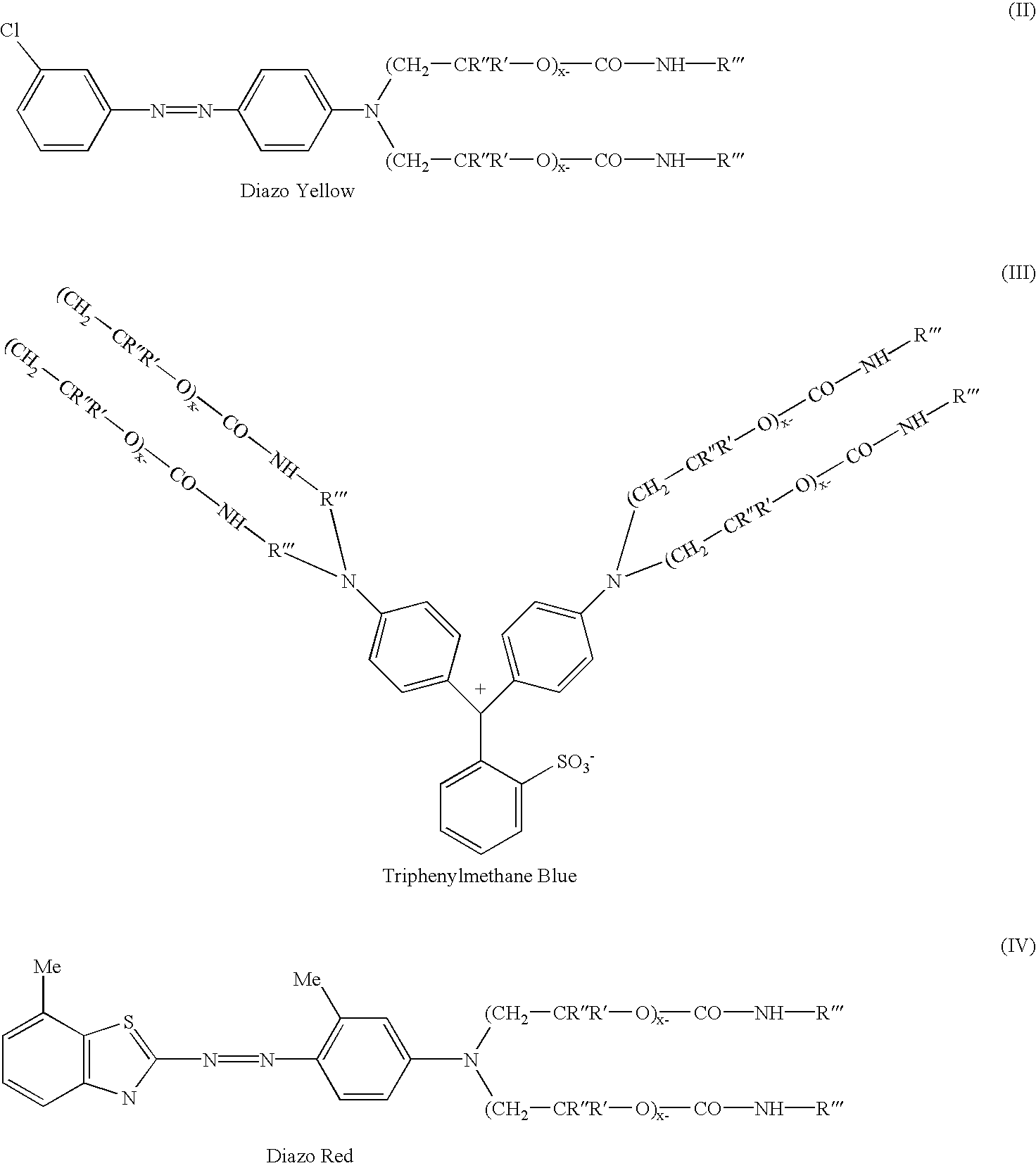Colorants for use within ink systems
a colorant and ink technology, applied in the field of colorants for use within ink systems, can solve the problems of inability to tailor wax- and/or oil-solubility or compatibility, unreactive colorants, and hydroxyl groups of such poly(oxyalkylenated) colorants and/or dyes, and achieve excellent spectral strengths, increase ink tack, and heat stability of the entire ink system
- Summary
- Abstract
- Description
- Claims
- Application Information
AI Technical Summary
Benefits of technology
Problems solved by technology
Method used
Image
Examples
example 2
100 parts of the polyoxyalkylene (having an ethylene oxide to propylene oxide ratio of about 1:1, and an average of about 5 moles of each alkylene oxide present thereon) substituted aniline intermediate were charged into a reactor vessel with 98 parts of octadecylisocyanate, and 2.0 parts of dibutyltindilaurate catalyst. The mixture was heated with stirring to 70.degree. C. under a N.sub.2 atmosphere. After 4.0 hours at 70.degree. C. an FT-IR spectrum of the product was obtained to insure all isocyanate functionality is consumed. The absence (disappearance) of a peak at about 2275 cm.sup.-1 (NCO) and the appearance (or increase in magnitude) of peaks at about 1740-1680 cm.sup.-1 and about 1540-1530 cm.sup.-1 corresponding to urethane frequencies, thereby confirm the conversion of the isocyanate to the urethane.
Colorant Production
The general methods of making the preferred inventive colorants are as follows:
example 3
(Diazo--Yellow)
135 parts of 98% sulfuric acid was charged to a flask containing 452 parts of water followed by 111 parts of 3-chloroaniline and 12 parts of 2-ethylhexanol. This mixture was allowed to stir for 0.5 hr. Separately a mixture of 71.3 parts of sodium nitrite and 233 parts of water was prepared in a beaker. This was charged to the flask slowly, keeping the temperature of the contents in the flask between 0 and 5.degree. C. After the addition is complete, the contents were allowed to stir for 2 hours while maintaining a temperature between 0 and 5.degree. C. In a separate beaker, coupler was prepared by mixing 683 parts of the intermediate prepared in Example 1 with 683 parts of toluene. The diazonium salt in the flask is added to the coupler slowly maintaining a temperature <10.degree. C. After the addition is complete, the mixture is allowed to stir for 1 hour. The acid is neutralized with a caustic solution, the product washed with water, and dried. A UV / VIS spectrum of ...
example 4
(Triphenylmethane--Blue)
1000 parts of the intermediate from Example 1 was charged to a flask containing 66 parts of p-dimethylaminobenzaldehyde and 14 parts of urea. To this mixture was charged 90 parts of muriatic acid over a 5 minute period. This mixture was allowed to heat up to 95-105.degree. C., and maintained at this temperature overnight. At the end of the hold period, the reaction mixture was allowed to cool to 75.degree. C., and 120 parts of p-benzoquinone was added. The mixture was allowed to stir for 1.5 hrs maintaining a temperature of 75-85.degree. C. The acid is neutralized with a caustic solution, the product washed with water, and dried. A UV / VIS spectrum of the bright mid range blue product shows a lambda max absorbances at 548 nm and 607 nm in toluene.
PUM
| Property | Measurement | Unit |
|---|---|---|
| temperature | aaaaa | aaaaa |
| temperature | aaaaa | aaaaa |
| temperature | aaaaa | aaaaa |
Abstract
Description
Claims
Application Information
 Login to View More
Login to View More - R&D
- Intellectual Property
- Life Sciences
- Materials
- Tech Scout
- Unparalleled Data Quality
- Higher Quality Content
- 60% Fewer Hallucinations
Browse by: Latest US Patents, China's latest patents, Technical Efficacy Thesaurus, Application Domain, Technology Topic, Popular Technical Reports.
© 2025 PatSnap. All rights reserved.Legal|Privacy policy|Modern Slavery Act Transparency Statement|Sitemap|About US| Contact US: help@patsnap.com



